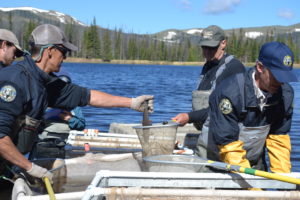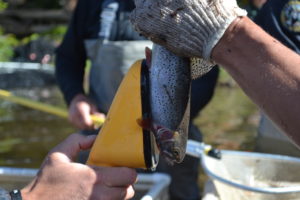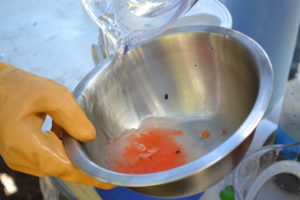By Dan Omasta(All photos courtesy of Helen H. Richardson/The Denver Post)
It was turning out to be another beautiful July day in Colorado, as over 50 staff and volunteers from Trout Unlimited, Colorado Parks and Wildlife (CPW) and various other government agencies and NGOs filed into the big dirt parking lot at the trailhead of Herman Gulch, just off I-70 west of Denver near Silver Plume.
Excitement was palpable, and everyone was ready to strap on their boots to help make a big difference for a small native trout—the greenback cutthroat.
The greenback, once believed to be extinct, is making a comeback in Colorado. Thanks to the efforts of state and federal agencies, NGOs and community volunteers, this threatened species is getting the boost it needs to return to its native range in the South Platte basin. In 2012, genetic scientists at the University of Colorado discovered a handful of the once-prolific trout in a small creek just outside of Colorado Springs. Since then, biologists from CPW, the U.S. Forest Service and U.S. Fish and Wildlife, with boots-on-ground assistance from Trout Unlimited, have been collaborating to rebuild critical population strongholds along the Front Range.
Repopulating Herman Gulch with greenbacks is a big step in that effort.
As the hatchery trucks arrived with their big tanks full of eager (and presumably confused) fish, we all gathered behind the tailgate of a CPW truck and received instructions for transporting and releasing our native cargo. Then we separated into five groups that corresponded to certain distances along the trail: group five, for instance, would be hiking the full 3.5 miles above treeline, while group one would begin releasing fish in a particular stretch only a mile into the trek.
Everyone was excited as we lined up to get outfitted with our fish packs. Each TU volunteer and agency staff person would be carrying 15-20 yearlings (4-7 inches long) up the steep rocky trail into the remote, high-alpine headwaters.
The first mile of the hike was brutal--steep switchbacks made up the bulk of the first two hours of climbing. The whole experience felt like a Tough Mudderrace combined with community conservation. The fish only had a few hours of oxygen in the bags, so volunteers slated to reach the highest stretches of stream moved quickly up the rocky, wooded path. Teams of fish packers often leap-frogged one another and received words of encouragement on the steady climb upward: “Almost there,” “It’s just around the corner,” “Sure, that’s what you said an hour ago!”
The hike was full of sweat, laughter and camaraderie as the group worked together to help establish this new population of native fish.
We had received instructions about where to release the fish along the small stream. Once our group reached our ¾ mile reach, we started looking for good habitat to release the fry. Volunteers split off from the group as they followed the sound of riffles and changes in gradient that suggested that on the other side of those willows would be a perfect eddy for these hungry, native trout.
At one bend, I unshouldered the pack and gently opened it along the bank. I set the bag of eager yearlings into the water to help them acclimate to the cold water—a process similar to bringing home that goldfish from the pet shop. About 15 minutes later, the fish were ready. As I poured the precious contents into the stream, the small greenbacks—maybe a dozen of them— swam eagerly out of the bag and into their new home in the clear, deep eddy by the undercut bank.
At first, they clumped together, seemingly unsure about where to go or hide in the cold, clear water. Then, a few of them finned into the current and began rising to the small mayfly hatch coming off the surface. These fish were raised in captivity, but generations of native instinct seemed to kick in almost immediately.
Repopulating a high alpine stream with fish that have never had to survive in such a harsh landscape continues to pose challenges. While these trout have done well in areas such as Zimmerman Lake, they must learn quickly the survival traits necessary to overcome runoff, ice flows and changing food patterns if they are going to stand a chance here. If this introduction is successful and the fish overwinter, Herman Gulch will become one of the first major streams to hold a significant population of pure greenback cutthroats.
This was a major undertaking and could not have been done without the dedication and resources of CPW biologists and hatchery technicians, federal agencies, NGOs and community volunteers. At the end of the day, our group helped to release 960 native greenbacks into Herman Gulch.
For me, the project also provided a shining example of teamwork and collaboration to counter the ongoing bitter partisanship and gridlock that has plagued our nation for years now. There we all were at 10,000 feet—families, retired nurses, young professionals, hunters, anglers, Democrats, Republicans, veterans and CEOs—all strapping on our hiking boots and working together to restore the greenback.
It was a good reminder of what can be accomplished when we work together.
For more information on greenback cutthroat trout recovery efforts, visit www.Coloradotu.org, or contact Dan Omasta, Colorado Trout Unlimited grassroots coordinator, at domasta@tu.org.









 CPW set up at the Zimmerman Lake inlet to capture spawning Greenbacks.
CPW set up at the Zimmerman Lake inlet to capture spawning Greenbacks. Fish were collected with a large net and put into a pen to be sorted and categorized by CPW staff and volunteers.
Fish were collected with a large net and put into a pen to be sorted and categorized by CPW staff and volunteers. Fish were sorted based on their gender and stocking year.
Fish were sorted based on their gender and stocking year. RFID chips in the fish help to identify the stocking year and other critical data.
RFID chips in the fish help to identify the stocking year and other critical data. After the fish were sorted, CPW milked the males and females - making targeted genetic crosses among the various lineages to expand the genetic diversity. The eggs and sperm were combined in bowls, packed into small coolers, put on ice, and shipped to the local fish hatchery in Leadville, CO for breeding.
After the fish were sorted, CPW milked the males and females - making targeted genetic crosses among the various lineages to expand the genetic diversity. The eggs and sperm were combined in bowls, packed into small coolers, put on ice, and shipped to the local fish hatchery in Leadville, CO for breeding.
